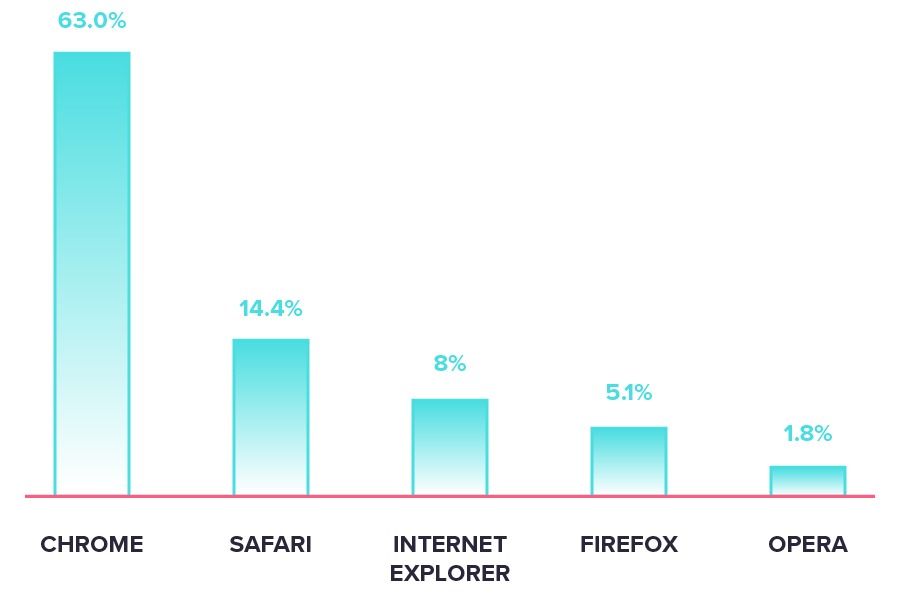Digital marketing post third-party cookies – a 2024 update
April 19, 2021
Are you looking for answers after Google’s announcement to remove third-party cookies? You’re not alone.
On March 3rd last year, Google announced it will not build alternate tracking identifiers with similar cross-site tracking abilities after phasing out third-party cookies. This change will be made by Google in late 2023.
While this announcement may not have come as a surprise, many advertisers find themselves confused about how to manage the situation.
Google will instead be using a technology developed from Google’s Privacy Sandbox. So-called FLoCs (Federated Learning of Cohorts) will target individuals based on larger groups of people with similar interests and behavior.
This means that advertisers will not be able to use third-party cookies for tracking users on Chrome. Digital advertisers will need to find new ways to attribute conversions, frequency cap ad placements and retarget site visitors.
Ad tech companies are now working on solutions to maintain the same type of performance and tracking alternatives for digital advertisers.
This article explores the future solutions that benefit advertisers while at the same time increasing user privacy.
At the beginning of 2022, Google presented a new solution: Google Topics.
Read more about Google Topics here.
Here is what happened
Google announced at the beginning of 2020 their plans to remove third-party cookies for Google Chrome. Chrome is the most common browser with over 63% of the market share globally.

Advertisers and publishers were concerned if Google would have a plan to replace cookie tracking technology in Chrome.
In March 2021, Google confirmed the plan to remove third-party tracking data and announced to not replace it with similar cross-site tracking technology.
That’s why David Temkin, Director of Product Management, Ads Privacy and Trust at Google made big news when he announced:
“…today, we’re making explicit that once third-party cookies are phased out, we will not build alternate identifiers to track individuals as they browse across the web, nor will we use them in our products.”
Google will still be able to track users through data collected from its services such as Maps, Search, or Youtube. The company said the changes only apply to ad tools and unique identifiers for websites.
Google will also still track and target users on mobile devices. It will still target ads to users based on their behavior on its platforms, which make up the majority of its revenue and won’t be affected by the change.
In other words, while the announcement will have huge implications for the digital ad industry, it probably won’t for Google itself.
Instead, Google will implement interest-based targeting through Google Topics that group individuals together based on interests. This isn’t however a replacement for cookies since there will be no ability for frequency capping, targeting based on browsing behavior, or conversion attribution.
How the Cookie Crumbles
Third-party cookies are small pieces of data stored on an internet user’s browser. These cookies contain third-party data, such as user identification.
Combined with tracking scripts, third-party cookies can be used for retargeting, user tracking, and conversion attribution.
For example, you can have a “Like” button on your website which will store a cookie on a visitor’s computer, that cookie can later be used by Facebook to identify visitors and see which websites a user has visited.
This is what’s known as a third-party cookie.
Advertisers have for years been using this technology to collect data and target relevant ads toward proper audiences.
This doesn’t mean that third-party data is the perfect technology for what it was used for, rather the contrary. It’s “good enough”.
Advertisers won’t get information on the user by cookies, but rather the specific browser on a device. This makes it difficult for advertisers to cross-device tracking of users.
From the user’s perspective, cookies lack an obvious opt-out function from being tracked or an opt-in alternative to access site content.
Some argue that the reappraisal of cookies is long overdue. As cookies are phased out, a new, better solution will be born. Future solutions with better targeting capabilities and higher privacy standards are already in the making.
The coming years will show that there are better user-identifier solutions than 3rd party cookies.
What the Future Holds for Digital Advertisers
To clarify, there will be user-level identifiers, just not developed by Google.
If there is no substitution for 3rd party cookies, up to 90% of all display impressions will have no ID attached to them. Though the details remain uncertain, it’s clear that solutions from Google’s Privacy Sandbox will not be enough.
To effectively target at scale in the post-cookie world, it’s necessary to adopt a portfolio of approaches that includes solutions to intelligently target ads without clear identifiers.
The result of removing targeted advertising will impact everyone; internet users, digital advertisers, and publishers.
Without proper tracking capabilities, advertisers will not be willing to invest as much in digital advertising. Simply put, brands want to show ads to those interested in their products, and are willing to pay a much higher price for potential customers.
With digital advertising inventory valued lower due to lack of tracking, publishers will have to find other ways of generating revenue. Most likely for a subscription-based payment model.
Digital advertising networks are however working on creating a solution better than the current technology and there are already promising alternatives.
How Digital Advertising Will Look in the Future
When third-party cookies are removed, advertisers will have to use different solutions for retargeting campaigns and measuring attribution.
The Trade Desk’s open-source Unified ID 2.0, Neustar’s Fabrick ID, and LiveRamp’s ATS aim to create shared cookieless identity solutions. This is done by the collaboration of industry partners to keep the internet open while maintaining consumer privacy and the interest of publishers and advertisers at heart.
One solution is using 1st party data to find the information needed. Ad tech companies such as Xandr and The Trade Desk are currently developing ways of tracking users while maintaining a higher standard of privacy.
Xandr has shared its multi-faceted approach to identity solutions. The solution will facilitate high-value transactions for buyers and sellers post 3rd-party cookies.
This solution enables advertisers to flexibly work with first-party data, including authenticated user data, contextual solutions, and technology to execute audience-based buying across screens.
Xandr’s solution will support browser-provided frameworks and ad serving without personal data.
“Xandr’s end-to-end platform meets the needs of our global client base as well as the broader industry while maintaining high respect for consumer privacy”, said Ewa Maciukiewicz, Senior Director, Product Management, Xandr.
The removal of third-party cookies may also change the digital landscape. More brands are looking into contextual advertising and good management of first-party cookies as an alternative. This could result in an increase in new ways of digital marketing.
Find out more in our article about the 2022 digital marketing trends.
Unified ID 2.0
Unified ID 2.0 is an approach gaining traction lately, with the support of most larger ad exchanges, such as Xandr and The Trade Desk.
Unified ID 2.0 is a collective industry effort to create identifiers for users on the internet while maintaining user privacy. It will act as a new, improved version of cookies as an identifier.
A user will log into a website with their email address and an identifier is created based on an anonymised version of that email address. This identifier will regularly regenerate itself to ensure security.
Unified ID 2.0 is compared to cookies developed so the internet user can set their preferences to how data is shared – putting the consumer in the driver’s seat.
If the user logs in through a supply partner that operates in Unified ID 2.0 they get the added benefit of being automatically logged in to any site that’s part of that supply network.
“FLoC is an innovative idea and useful, but it won’t be able to pay off the value exchange of the internet in the same way that cookies did or that Unified ID 2.0 will. As one of the most vocal advocates of the open internet, I’m delighted that Google is investing in FLoC and privacy sandbox, but I think it is a mistake to assume those efforts will fill the hole that Google creates when eliminating third-party cookies”, said Jeff Green, Founder, and CEO of The Trade Desk.
How Advertisers Are Affected
The post-cookie ecosystem is still uncertain. One certain thing is that advertisers, publishers, and users will all be affected.
Open-source digital frameworks such as Unified ID 2.0 are a result of broad collaboration among publishers, tech providers, and buyers. The willingness to adapt and develop a new solution to improve tracking and user privacy is a high priority for ad tech companies in 2021.
We are an agnostic advertising platform and are closely following updates from Google, The Trade Desk, Xandr, and other tech partners. We have the flexibility to choose the best solution for our client’s performance.
We see the creation of an alternative to cookies, where internet users can opt-in or out of sharing data and receiving ads, as a positive development.
The future programmatic ecosystem will be more flexible and Match2One’s platform will integrate with the highest performing alternative. With the multiple solutions available, we will act as a filter for advertisers to manage the transition.
Users that opt into sharing data for their benefit, such as higher ad relevance or accessing content, will also be more relevant to the advertiser.
The results are likely to be higher ad relevance and better user experience and more cost-efficient targeting for brands.
Conclusion
The open internet will benefit by taking a step from third-party cookies.
Google’s announcement was not surprising, and Match2One continues the plan to adapt to a cookie-less internet. Match2One is well prepared for the transition and continuously following the developments from adtech providers.
With continuous testing of partly Google’s Privacy Sandbox and FloC solution, adtech providers are finding where further development is needed.
Brands and advertisers may be worried about how to manage the new solution. Match2One has the capabilities to find the best solution for brands and act as the filter for brands.
Google’s announcement was big news, but not surprising. The entire adtech industry has been working together on creating a solution that will benefit brands, publishers and users.
Leave a comment
You must be logged in to post a comment.



3 comments
Handy guide to a thorny subject! Something we’re exploring further in affiliate network tracking and cookie analysis at Moonpull